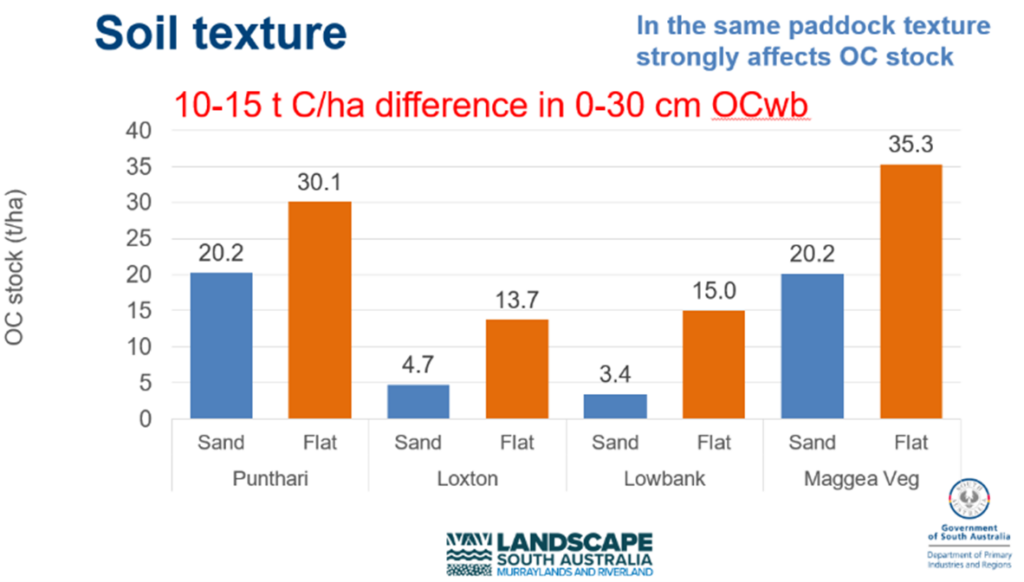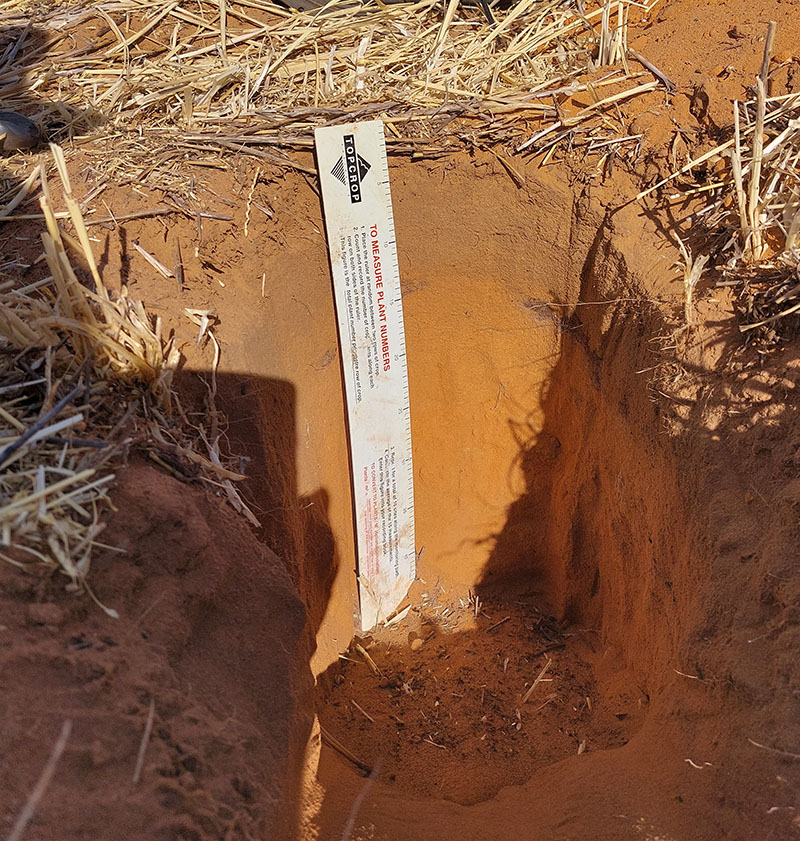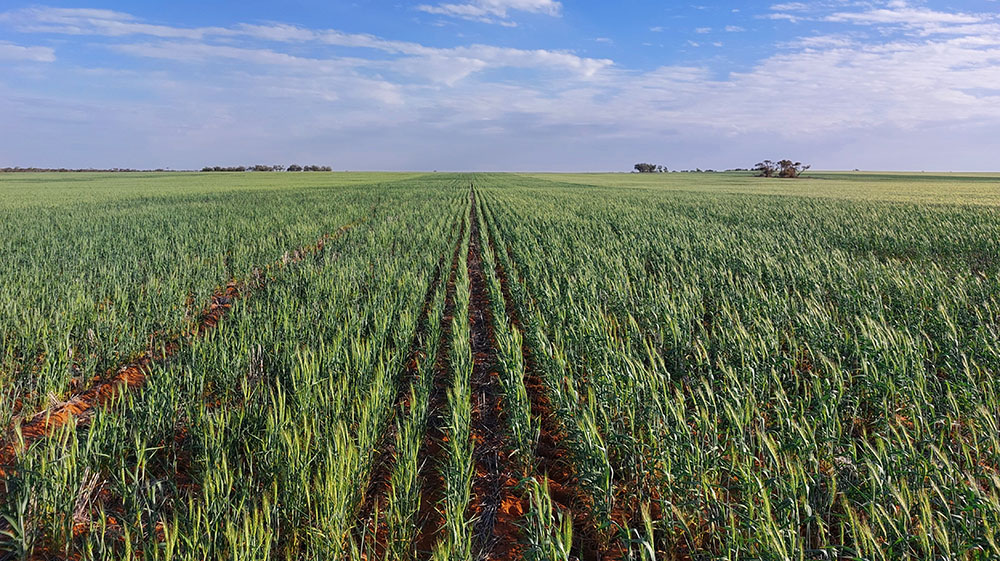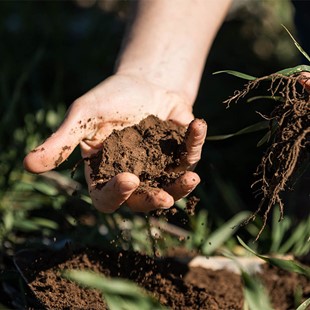This fact sheet supports the ‘Opportunities for soil carbon management in Southwest NSW’ webinar, delivered as part of the ‘Soil carbon capacity building resources for farmers and advisors’ project, proudly supported by the NSW Department of Climate Change, Energy, the Environment and Water (DCCEEW).
Soil carbon is a hot topic in agriculture, but what does it really mean for farmers in low-rainfall areas like the Mallee? In this webinar, Dr Karl Andersson (NSW Department of Primary Industries and Regional Development) and Amanda Schapel (Department of Primary Industries and Regions South Australia) explore:
- What soil carbon levels can be expected in the Mallee
- What factors influence soil carbon
- What management practices can be used to increase soil carbon levels.
Key messages
- Soil organic carbon (SOC) is a component of soil organic matter (SOM), derived from previous plant growth and associations.
- SOC is naturally low in Mallee soils, and highly variable.
- Protect the soil carbon you have.
- Building soil carbon is possible but takes time, sequestration rates are likely to be low, and detecting and maintaining an increase is difficult.
- Think carefully before registering a soil carbon project in the Mallee, since the potential to increase may be limited and increases can be lost – the best chance of viability is in soils with a low starting point.
- The main benefit of maximising soil carbon in the Mallee is that higher carbon soils are more resilient and more productive, leading to reduced ‘emissions intensity’ (emissions per unit of product) – consider detectable increases in soil carbon stock a bonus.
- Organic matter is essential for healthy soil function, which involves both carbon loss and renewal (i.e. carbon cycling). The focus is on maintaining an active cycle and steady throughput, with the goal of ensuring inputs exceed outputs to build reserves over time.
Soil organic carbon is naturally low in Mallee soils, and highly variable
SOC is critical for soil health, contributing to nutrient cycling, water retention, biological activity, and overall soil structure. In the Mallee, SOC levels are relatively low (< 1%) because:
- low and variable rainfall conditions mean less plant growth, so less carbon is drawn into the system
- soils are generally sandy, with minimal clay content, leading to more rapid breakdown of organic matter in the soil, returning fixed carbon to the atmosphere.
In the sandy soils typical of the Mallee, SOC concentrations are highest in the top 10 cm (generally in the range 0.3% to 0.75%) and decrease with depth. The total amount of SOC in the topsoil (0-30 cm) is typically around 2 to 8 tonnes per hectare. SOC levels vary with topography and soil type, so intensive sampling across different soil types is required to accurately measure SOC stocks.
In the Mallee, soils are typically zoned into different soil types (often dunes, mid-slopes and flats – see Figure 1) prior to soil sampling and multiple samples are taken from different depths within those zones to estimate SOC stock in each soil type. Taking more soil samples across a field ensures a more representative and accurate assessment of soil health and fertility, leading to better-informed decisions about fertiliser application and overall crop management.

Protect the soil carbon you have
The first and most realistic goal in carbon management in Mallee soils is to minimise carbon loss. When paddocks are eroded by wind, a lot of what blows away is organic matter because it is lighter than the mineral soil (sand, silt and clay).
Maintaining ground cover to reduce erosion losses is one of the most important things a land manager can do: no-till seeding, avoid overgrazing, and avoid burning crop residues are all essential for good soil carbon management. Research has shown that maintaining at least 50% cover decreases wind erosion (Source: Managing ground cover in the cropping zone of southern NSW).

Building soil carbon is possible, but it takes time, sequestration rates are likely to be low, and you may not be able to detect the improvement
Any management technique that leads to more biomass production improves carbon inputs to the soil, and is likely to be positive for not just yield but also soil carbon over the long term (>10 years). Key approaches that may improve carbon stocks include:
- liming to overcome acidity
- better nutrition (conventional or organic fertilisers)
- deep ripping of compacted sandy soils to improve root depth and moisture availability
- claying (clay spreading or delving) of sands >30 cm deep to improve water and nutrient holding capacity and to protect SOC from breakdown
- growing perennial plants (e.g. perennial pastures), where possible, and using rotational grazing to maximise root biomass.
A 2010 review of the impacts of improved management (e.g. no till, stubble retention), suggested average sequestration rates of around 0.2 to 0.3t C/ha per year after the management change (source: Soil Carbon Sequestration Potential: A review for Australian agriculture). However, it is noted that some of the approaches listed above may lead to greater emissions or carbon losses in the short term. In the Mallee environment, sequestration rates may well be below that range due to relatively low biomass production and the lack of protection of carbon in sandy soils.
Sequestered soil carbon can be lost in dry years where there are minimal carbon inputs, although dry conditions result in lower microbial respiration of ‘old’ soil organic carbon, so soil organic carbon levels may be preserved. In the future, a drying and warming climate may make it more difficult to build soil carbon due to less consistent inputs of organic matter.
Detecting small changes in carbon stock requires intensive soil testing, especially in variable soils, so it may take many years before changes can be detected. The major benefit from soil improvement may well be improved productivity.
Registering a soil carbon project in the Mallee
The Australian Government’s Clean Energy Regulator has developed methods to monitor and recognise soil carbon sequestration in agricultural soils (available at https://cer.gov.au/). Registering projects takes considerable investment in time and soil testing, and projects need to be run for a minimum of 25 years. Most soil projects registered so far are in higher rainfall zones and involve perennial pastures and rotational grazing. The viability of soil projects in the Mallee may improve as new techniques are identified to sequester carbon, or as new ways are developed for measuring changes.
The main benefits of maximising soil carbon in the Mallee are better production and reduced ‘emissions intensity’
The primary benefit of maximising soil carbon levels (or minimising soil carbon losses) in the Mallee is likely to be improved production, achieved through nutrient cycling, water infiltration and storage, and improved soil structure.
By growing more with similar inputs, emissions intensity (emissions per unit of product) is likely to reduce. This figure can be calculated using freely available greenhouse gas emissions calculators. Keeping track of improvements in emissions intensity may improve future market access if buyers of agricultural products look to reduce emissions associated with their products.
Steps to take right now
- Minimise tillage.
- Maintain 50% ground cover.
- Overcome soil constraints to increase biomass, applying inputs where practical and economically viable.
- Add clay to sandy soils where appropriate.
- Use a greenhouse gas calculator to work out your emissions intensities for grain and livestock production and keep records over multiple years.
- Keep track of technical developments that may make soil carbon sequestration more viable in future.
On most Mallee farms, optimised soil carbon management is about protecting the carbon you already have, and maximising plant growth to support production, carbon inputs, soil health and nutrient cycling. Maximising yield per unit of input often reduces your emissions intensity, which is a win for you and the environment.


Prepared by the Soil CRC and their participants as part of the ‘Soil Carbon Capacity Building Resources for Farmers and Advisors’ project, proudly supported by NSW DCCEEW.


